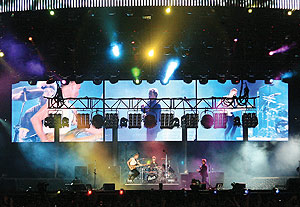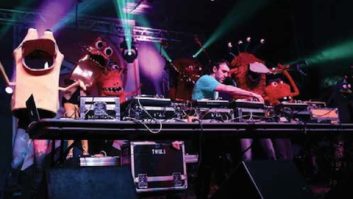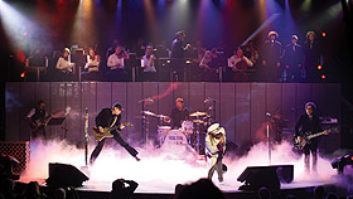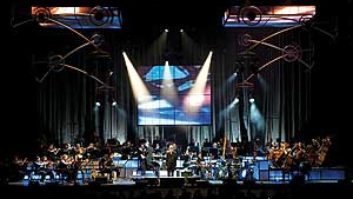

It’s gotta be a tough gig: You’re mixing for one of the most recognizable names in rock history who have not toured together — or produced music together — in almost 23 years. Fans pour into the packed stadiums, shelling out top money per seat (the band is donating a portion of the proceeds to WaterAid, a nonprofit organization dedicated to improving sanitation and safe-water access in poor countries), just to get a glimpse of vocalist/bassist Sting, drummer Stewart Copeland and guitarist Andy Summers perform such classic Police hits as “Message in a Bottle,” “Driven to Tears” “Murder By Numbers” and so many more from their currently $22 million-selling catalog. Sting told Rolling Stone in an interview during tour rehearsals in Vancouver that he committed to a world tour “to go back, retrace those steps and make the band better. I have played these songs for years. I know things about the music I didn’t know then or couldn’t express. I’m a better bandleader now than I was then.”
But with all of this pomp and circumstance surrounding the tour, it’s nice to see front-of-house engineer Mike Keating and monitor engineer Ian Newton staying calm, cool and collected.
And why not? Keating has been mixing in that capacity for Sting since 1992, while Newton was brought onboard for the last Sting tour, so it’s no surprise that they were selected to work on this world tour. “Perhaps I was an obvious choice to maintain some sort of coherency between [Sting’s] solo stuff and The Police,” Keating says.
But that’s just working with Sting. What happens when you bring back the other two original members who haven’t worked with these engineers before? One would think that that in itself could cause some rough transitions and thinking on their feet. But when we catch up with the tour at Oakland, Calif.’s McAfee Coliseum, Keating reassures Mix that neither he nor Newton have really encountered any difficulties with the transition from a solo tour to a reunion one, other than the styles of playing.
“Basically,” he continues, “being flexible is just part of the mixing — adapting to acoustics and so forth. Also, with a three-piece band, it is inherently raw musically; the band is always evolving and it keeps me on my toes. No set-and-forget here!”
CAST OF CHARACTERS
While both engineers are mixing off the hip during the show, having a full rig — as well as a full cast of tech crew — supplied by Clair Bros. provides a baseline each night from which to draw. “Ian and I have pretty much hand-picked our crack staff from the rosters of Clair Showco,” Keating says. On-hand to help out in any way are Kirk “Eek” Shreiner, FOH system engineer; Aaron Foye, monitor tech/Pro Tools recorder; Tom “Duds” Ford; Sean Bacca; Larry “Redfish” Wilson; and Shaun “Nob” Clair, who, as Keating describes, is working on his “summer boot camp project. We’re super-glad he joined us. Their hard work and tireless work ethic is second-to-none and is greatly appreciated by myself, Ian and all onstage.
“The P.A. system is a bit of a hybrid,” continues Keating, who is also a 24-year employee of the sound company. “We’re using a combination of Clair Bros. i4s and S-4 subs. The subs are both flown and ground-stacked. This P.A. is the best of both worlds: the clarity of the line array, along with that famous S-4 bottom end! It’s bad ass! Every night when Sting steps on the Taurus pedals, the audience roars for the subs that may blur their vision, among other things. We have headroom for days.”
As the tour is playing to just about every major city in the U.S. — selling out boomy stadiums and arenas, as well as hitting the festival circuit with such notable events as Live Earth (in New Jersey), Bonnaroo Music Festival and Virgin Festival — before jumping the pond to the UK and other destinations in Europe, Keating is constantly mixing for each venue and how it interacts with the P.A. “That’s the challenge with live sound,” he explains. “If it were easy, anyone with a basement Pro Tools rig or GarageBand program and a bit of mixing experience could do it. I don’t really like to mix all that loud, and in some venues it just sounds worse the more you turn it up. I prefer the sound to be large and not painful. I am instructed to turn it up, and so far no one has complained to my knowledge.”
Keating is mixing on a Yamaha PM5000 analog board, using 65 inputs, including effects returns; most of the inputs are designated for percussion. When I ask why he’s using an analog board, especially when he’s running that many inputs, Keating replies, “Yes, it is analog, and may always be. I am just too old school for the digital thing, and every time my laptop crashes or does something on its own, I am that much further from using a mouse to earn a living. Quoting a close audio engineer friend of mine, ‘You could mix the show on a Crackberry, but I’d rather have my knobs connected to real audio.’
“I’m using the Lexicon 480, and PCM 70, 90 and 91 units on everything,” Keating continues. He’s also putting quite a bit of effects on Sting, using a TC-Helicon VoiceWorks vocal harmony processor, which makes one voice into as many as four voices, and a Vocal Doubler and 2290 delay unit on vocals.
Newton is also handling 65 inputs, but he’s working on a digital Yamaha PM1D, adding that all of his effects are onboard.
“We’re using a combination of ears and wedges,” Newton says. “Sting has Clair Bros. 12AM wedges and Future Sonics Ear Monitors. Andy has Clair 12AM wedges and Ultimate Ear monitors. Stewart has Ultimate Ears and a ButtKicker fitted to his drum stool. We have Clair Bros. R4 sidefills. All of the ear systems are Sennheiser G2 RF systems. We also use Sennheiser RF systems for Stewart’s headset mic and the guitar and bass.”
Newton is giving each bandmember a straightforward mix: Everyone has a good bit of themselves and a bit less of everything else. Seems that the mix really does mirror the band’s rocky breakup and the perceived personal disconnect on this tour. Fortunately, their music still binds them together onstage — and the fans love it.
Sarah Benzuly is the group managing editor for Mix, Electronic Musician and Remix magazines.
Mic List
Vocals: Sennheiser 865
Drum kit:
Kick: Shure Beta 52, SM91
Snare: SM57 (top), Neumann KM184
(bottom)
Toms: Beyer Opus 87s, 88s
Overheads: Audio-Technica 4050s
Splash Cymbals: Neumann KM184
Guitars: 3x Audio-Technica 4050
Percussion: Neumann KM184s (overheads,
bells), Beyer Opus 87s (toms), Beta 52
(bass drum)
Timpani: Sennheiser 421




